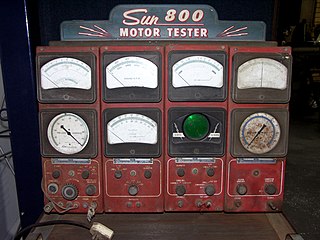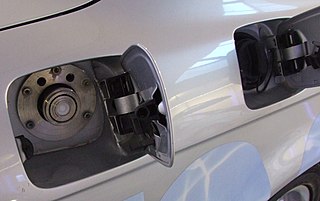
An engine or motor is a machine designed to convert one or more forms of energy into mechanical energy.

Cosworth is a British automotive engineering company founded in London in 1958, specialising in high-performance internal combustion engines, powertrain, and electronics for automobile racing (motorsport) and mainstream automotive industries. Cosworth is based in Northampton, England, with facilities in Cottenham, England, Silverstone, England, and Indianapolis, IN, US.

A four-strokeengine is an internal combustion (IC) engine in which the piston completes four separate strokes while turning the crankshaft. A stroke refers to the full travel of the piston along the cylinder, in either direction. The four separate strokes are termed:
- Intake: Also known as induction or suction. This stroke of the piston begins at top dead center (T.D.C.) and ends at bottom dead center (B.D.C.). In this stroke the intake valve must be in the open position while the piston pulls an air-fuel mixture into the cylinder by producing a partial vacuum in the cylinder through its downward motion.
- Compression: This stroke begins at B.D.C, or just at the end of the suction stroke, and ends at T.D.C. In this stroke the piston compresses the air-fuel mixture in preparation for ignition during the power stroke (below). Both the intake and exhaust valves are closed during this stage.
- Combustion: Also known as power or ignition. This is the start of the second revolution of the four stroke cycle. At this point the crankshaft has completed a full 360 degree revolution. While the piston is at T.D.C. the compressed air-fuel mixture is ignited by a spark plug or by heat generated by high compression, forcefully returning the piston to B.D.C. This stroke produces mechanical work from the engine to turn the crankshaft.
- Exhaust: Also known as outlet. During the exhaust stroke, the piston, once again, returns from B.D.C. to T.D.C. while the exhaust valve is open. This action expels the spent air-fuel mixture through the exhaust port.

The Kamkorp Group was a privately held holding company, encompassing a wide range of businesses but operates mainly as Frazer-Nash Research Ltd. It was owned by UK-based Indian businessman Kamal Siddiqi. Over the past 25 years, the Kamkorp Group has developed proprietary digital electric and hybrid electric powertrains and products for the transportation and industrial markets. The company has produced various automobile prototypes under the brands Frazer-Nash and Metrocab. Until 2020 it owned Bristol Cars, under which brand the Bristol Bullet sports car was being developed. The Bullet was unveiled on 26 July 2016 and production was to have started in 2017.

Engine tuning is the adjustment or modification of the internal combustion engine or Engine Control Unit (ECU) to yield optimal performance and increase the engine's power output, economy, or durability. These goals may be mutually exclusive; an engine may be de-tuned with respect to output power in exchange for better economy or longer engine life due to lessened stress on engine components.
Automotive engineering, along with aerospace engineering and naval architecture, is a branch of vehicle engineering, incorporating elements of mechanical, electrical, electronic, software, and safety engineering as applied to the design, manufacture and operation of motorcycles, automobiles, and trucks and their respective engineering subsystems. It also includes modification of vehicles. Manufacturing domain deals with the creation and assembling the whole parts of automobiles is also included in it. The automotive engineering field is research intensive and involves direct application of mathematical models and formulas. The study of automotive engineering is to design, develop, fabricate, and test vehicles or vehicle components from the concept stage to production stage. Production, development, and manufacturing are the three major functions in this field.

In a motor vehicle, the powertrain comprises the main components that generate power and deliver that power to the road surface, water, or air. This includes the engine, transmission, drive shafts, differentials, and the final drive. Hybrid powertrains also include one or more electric traction motors that operate to drive the vehicle wheels. All-electric vehicles eliminate the engine altogether, relying solely on electric motors for propulsion. Occasionally the term powerplant is casually used to refer to the engine or, less often, the entire powertrain.
Homogeneous Charge Compression Ignition (HCCI) is a form of internal combustion in which well-mixed fuel and oxidizer are compressed to the point of auto-ignition. As in other forms of combustion, this exothermic reaction produces heat that can be transformed into work in a heat engine.

Tickford is an automobile engineering and testing business in Newport Pagnell, Buckinghamshire, known for tuning and such products as the 140 mph Tickford Turbo Capri.
An engine test stand is a facility used to develop, characterize and test engines. The facility, often offered as a product to automotive OEMs, allows engine operation in different operating regimes and offers measurement of several physical variables associated with the engine operation.
Hybrid vehicle drivetrains transmit power to the driving wheels for hybrid vehicles. A hybrid vehicle has multiple forms of motive power.

Mahle GmbH is a German automotive parts manufacturer based in Stuttgart, Germany. It is one of the largest automotive suppliers worldwide. As a manufacturer of components and systems for the combustion engine and its periphery, the company is one of the three largest systems suppliers worldwide for engine systems, filtration, electrics, mechatronics, and thermal management. In 2018, Mahle's sales amounted to over €12.5 billion.

A hydrogen internal combustion engine vehicle (HICEV) is a type of hydrogen vehicle using an internal combustion engine. Hydrogen internal combustion engine vehicles are different from hydrogen fuel cell vehicles. Instead, the hydrogen internal combustion engine is simply a modified version of the traditional gasoline-powered internal combustion engine. The absence of carbon means that no CO2 is produced, which eliminates the main greenhouse gas emission of a conventional petroleum engine.

IKCO EF Engines are a family of four-cylinder engines by the Iranian car manufacturer Iran Khodro (IKCO). The first engines of this family were designed jointly by Iran Khodro Powertrain Company (IPCO) and F.E.V GmbH of Germany. The later models were designed by IPCO alone. IPCO is the powertrain design and production company of IKCO.

The Dunton Campus is a major automotive research and development facility located in Dunton Wayletts, Laindon, Essex, United Kingdom, which is owned and operated by Ford Motor Company. Ford Dunton houses the main design team of Ford of Europe alongside its Merkenich Technical Centre in Cologne, Germany. With the closure of Ford's Warley site in September 2019, the staff from the UK division of Ford Motor Credit Company and Ford's UK Sales and Marketing departments have moved to the Dunton site. As of November 2019, Dunton had around 4,000 staff working at the site.
Achates Power is an American developer of opposed-piston, two-stroke, compression ignition engines for use in commercial and passenger vehicles. Based in San Diego, California, the company was founded in 2004 by James U Lemke.

Alset Global GmbH is an Austrian technology and engineering company based in Graz specializes in hydrogen-based clean mobility products. Alset Global is known for developing a Hybrid Hydrogen capable of running an internal combustion engine on either pure petrol, pure hydrogen or a combination of both. technology offers a new sustainable and clean alternative to the automotive industry. The technology has been developed to create an alternative technology to meet new emission target levels. Alset Global also specializes in hydrogen system integration, hydrogen gas storage, and software development.
The Rover G-series engine is a range of inline-4 common-rail diesel engines designed and engineered by Powertrain Ltd, a sister company to MG Rover Group, and has been produced by Indian automotive multinational Sonalika Group since 2007.

Red Bull Powertrains, abbreviated as RBPT, is a Formula One power unit manufacturing company owned by the Austrian Red Bull GmbH and based in the United Kingdom. The company was formed in 2021 to take over the operation of Formula One power units developed by Honda from 2022 onwards following the Japanese manufacturer's withdrawal from the sport after 2021. Honda continued to support the Red Bull-owned teams in 2022 and will do so until the end of 2025. Honda assembles the power units and provides trackside and race operation support. The power units remain Honda's intellectual property, and due to a development freeze, Red Bull Powertrains will not develop them.
The RA is a 6.5-litre, naturally-aspirated V12 engine, commissioned by Adrian Newey, and designed, developed and produced by Cosworth for the Aston Martin Valkyrie sports car. The road-going engine is rated at 1,000 hp at 10,500 rpm, with a max torque figure of 740 N⋅m (546 lbf⋅ft) at 7,000 rpm, making it the most powerful naturally-aspirated engine ever fitted and used in a production road car. The engine also revs to a maximum of 11,100 rpm, and has a power density making 114.8 kW per litre.












